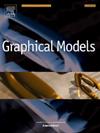Topology-controlled Laplace–Beltrami operator on point clouds based on persistent homology
IF 2.2
4区 计算机科学
Q2 COMPUTER SCIENCE, SOFTWARE ENGINEERING
引用次数: 0
Abstract
Computing the Laplace–Beltrami operator on point clouds is essential for tasks such as smoothing and shape analysis. Unlike meshes, determining the Laplace–Beltrami operator on point clouds requires establishing neighbors for each point. However, traditional -nearest neighbors (k-NN) methods for estimating local neighborhoods often introduce spurious connectivities that distort the manifold topology. We propose a novel approach that leverages persistent homology to refine the neighborhood graph by identifying and removing erroneous edges. Starting with an initial k-NN graph, we assign weights based on local tangent plane estimations and construct a Vietoris–Rips complex. Persistent homology is then employed to detect and eliminate spurious edges through a topological optimization process. This iterative refinement results in a more accurate neighborhood graph that better represents the underlying manifold, enabling precise discretization of the Laplace–Beltrami operator. Experimental results on various point cloud datasets demonstrate that our method outperforms traditional k-NN approaches by more accurately capturing the manifold topology and enhancing downstream computations such as spectral analysis.
基于持久同调的点云拓扑控制拉普拉斯-贝尔特拉米算子
计算点云上的拉普拉斯-贝尔特拉米算子对于平滑和形状分析等任务至关重要。与网格不同,确定点云上的拉普拉斯-贝尔特拉米算子需要为每个点建立邻居。然而,传统的k近邻(k-NN)估计局部邻域的方法经常引入扭曲流形拓扑的虚假连通性。我们提出了一种新的方法,利用持久同源性来改进邻域图,通过识别和去除错误边。从初始k-NN图开始,我们根据局部切平面估计分配权重,并构造一个Vietoris-Rips复合体。然后,通过拓扑优化过程,利用持久同源性来检测和消除假边。这种迭代的细化会产生更精确的邻域图,更好地表示底层流形,从而实现拉普拉斯-贝尔特拉米算子的精确离散化。在各种点云数据集上的实验结果表明,我们的方法通过更准确地捕获流形拓扑和增强下游计算(如频谱分析)来优于传统的k-NN方法。
本文章由计算机程序翻译,如有差异,请以英文原文为准。
求助全文
约1分钟内获得全文
求助全文
来源期刊

Graphical Models
工程技术-计算机:软件工程
CiteScore
3.60
自引率
5.90%
发文量
15
审稿时长
47 days
期刊介绍:
Graphical Models is recognized internationally as a highly rated, top tier journal and is focused on the creation, geometric processing, animation, and visualization of graphical models and on their applications in engineering, science, culture, and entertainment. GMOD provides its readers with thoroughly reviewed and carefully selected papers that disseminate exciting innovations, that teach rigorous theoretical foundations, that propose robust and efficient solutions, or that describe ambitious systems or applications in a variety of topics.
We invite papers in five categories: research (contributions of novel theoretical or practical approaches or solutions), survey (opinionated views of the state-of-the-art and challenges in a specific topic), system (the architecture and implementation details of an innovative architecture for a complete system that supports model/animation design, acquisition, analysis, visualization?), application (description of a novel application of know techniques and evaluation of its impact), or lecture (an elegant and inspiring perspective on previously published results that clarifies them and teaches them in a new way).
GMOD offers its authors an accelerated review, feedback from experts in the field, immediate online publication of accepted papers, no restriction on color and length (when justified by the content) in the online version, and a broad promotion of published papers. A prestigious group of editors selected from among the premier international researchers in their fields oversees the review process.
 求助内容:
求助内容: 应助结果提醒方式:
应助结果提醒方式:


